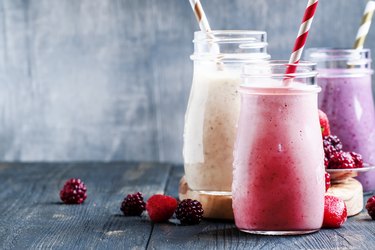Why You Shouldn’t Try the HMR Program for Fast Weight Loss in 2024

5PH/iStock/GettyImages
If you’re looking to drop pounds quickly, you might be tempted to try the HMR Program, which has been ranked first for fast weight loss on U.S. News & World Report’s best diets list in the past.
While the HMR Program is still accessible to new and existing participants online, there are some pros and cons about the diet you should know.
Video of the Day
Video of the Day
If you were looking to join, keep scrolling for a healthier approach to losing weight.
What Is the HMR Program?
The Health Management Resources Program, better known as the HMR Program, was a pre-packaged food plan created about 40 years ago by Lawrence Stifler, PhD. It’s been tested and used as a weight-loss approach in clinical settings. Many hospitals like NYU Langone Health, UC San Diego Health and Henry Ford Health System in Detroit have used HMR as a weight-loss program at their facilities.
The program touted “easy and convenient meal delivery” while providing you “a break from making any food decisions,” per HMR’s website.
There were three plans to choose from; the most basic included digital support and a starter kit of meals and shakes. This plan claimed that it could help you lose 12 pounds in just three weeks.
On the higher end, there was a plan with digital support, in-person support and all of the HMR weight-loss foods. This plan claimed to help you lose between 28 to 38 pounds in just 12 weeks.
What You Can (and Can’t) Eat on the HMR Program
The HMR at Home Program plan provided 1,200 to 1,500 calories each day and was broken into two phases.
During the first phase, you were allowed to eat three HMR shakes, two HMR entrées and five servings of fruits and vegetables each day. You stayed in phase one until you reached a goal weight or until you were ready to have less structure in your diet. A sample day in phase one might’ve looked like:
- Breakfast: HMR Multigrain Hot Cereal with 1 cup of
fruit - Snack: HMR Chocolate Shake
- Lunch: HMR Penne Pasta With Meatballs and 2 cups of
vegetables - Snack: 1 cup of fruit
- Dinner: HMR Savory Chicken and 2 cups of vegetables
- Snack: HMR Vanilla Shake with 1 cup of frozen fruit
If you were still hungry at the end of the day, the program recommended having an HMR pudding or bar to satisfy your snack craving.
Phase two, which was supposed to last four to eight weeks, was a transition phase where you began to eat fewer HMR-specific foods and instead incorporated nutritious “non-HMR low-calorie foods.”
On the HMR Program, especially during the first phase, you were encouraged to only eat HMR foods along with fruits and vegetables. The website had a database of recipes, but they all called for HMR-specific foods that you then added to.
One example was an Italian Tomato Bisque recipe that called for combining the HMR Lasagna with the HMR 500 Chicken Soup along with canned stewed tomatoes, Molly McButter (a brand of butter-flavored “sprinkles”) and fat-free sour cream.
Pros of the HMR Program
As with anything, HMR had positives and negatives. In our opinion, though, the bad outweighed the good. Here’s our breakdown of pros and cons:
1. Meal Delivery
Who doesn’t love the ease of a meal-delivery program? No cooking required here, nor having to think about what you’re going to eat.
2. Lots of Fruits and Veggies
More specific to this diet was the abundance of fruits and vegetables promoted at each meal. The diet encouraged at least five servings each day, which is right in line with the dietary guidelines for Americans, per the U.S. Department of Health and Human Services.
3. It Works
The diet was endorsed and used by hospitals across the country because, like almost any diet, it would help you lose weight. But as we know, sustainable weight loss and better overall health are more important than a quick drop on the scale — more on that below.
Cons of the HMR Program
1. It’s Expensive
The cost of the diet meant that it wasn’t accessible to everyone. The typical cost for three weeks of shakes and food delivery was about $300, and you still needed to supplement with trips to the supermarket.
2. Sodium Was an Issue
HMR foods were sometimes high in salt. For instance, the previous example of the Italian Bisque Soup recipe provided over 1,800 milligrams of sodium per serving — that’s about 80 percent of your total daily sodium needs in just one meal, according to the American Heart Association.
3. The Food Was Packed With Additives
The HMR foods and ingredients called for in recipes were also packed with artificial flavors, sweeteners and additives. Adding Molly McButter — made with maltodextrin — to the Italian Bisque Soup is a prime example.
Another recipe for a shake called for “sugar-free white chocolate syrup,” and the HMR protein powders themselves had the artificial sweetener aspartame.
According to U.S. News’ reporting, the diet also recommended you “consider temporarily limiting social activities that center around food” while on the diet. Any diet that encourages restricting your social life so that you can sit at home and carefully monitor your food intake isn’t a sustainable diet in our books.
The HMR Program was essentially saying you can’t have both a balanced diet and a social life, that they’re mutually exclusive. But the diet was failing to teach someone how to live a healthy life, which includes a healthy relationship with food while also maintaining social and fruitful relationships with friends and loved ones.
Want to Lose Weight Safely?
Set yourself up for success with LIVESTRONG.com’s Weight-Loss Kickstart program.
A Healthier Approach to Weight Loss
Any diet that claims you’ll “lose weight quickly” (while making you 100 percent reliant on their foods to do so) is one you should navigate with caution.
This is especially true when a diet’s foods are high in sodium, have subpar ingredients and you’re encouraged to limit any part of your social life that may center around food.
We understand it’s tempting to want to lose weight quickly, but it is not sustainable. Instead, a slower, more long-term approach that includes focusing on whole foods (versus ultra-processed foods and shakes) is the healthier route to go.
Indeed, researchers in a small May 2019 study in Cell Metabolism broke participants into two groups and found those on an ultra-processed diet naturally ate about 500 more calories each day (and gained one pound over the course of two weeks) compared to those on a less-processed, more whole foods diet. (Note: Both groups were presented with the same amount of calories in their corresponding diets.)
This shows that shifting away from ultra-processed foods and eating a whole foods-based diet may be better for our health and personal weight goals in the long run.




